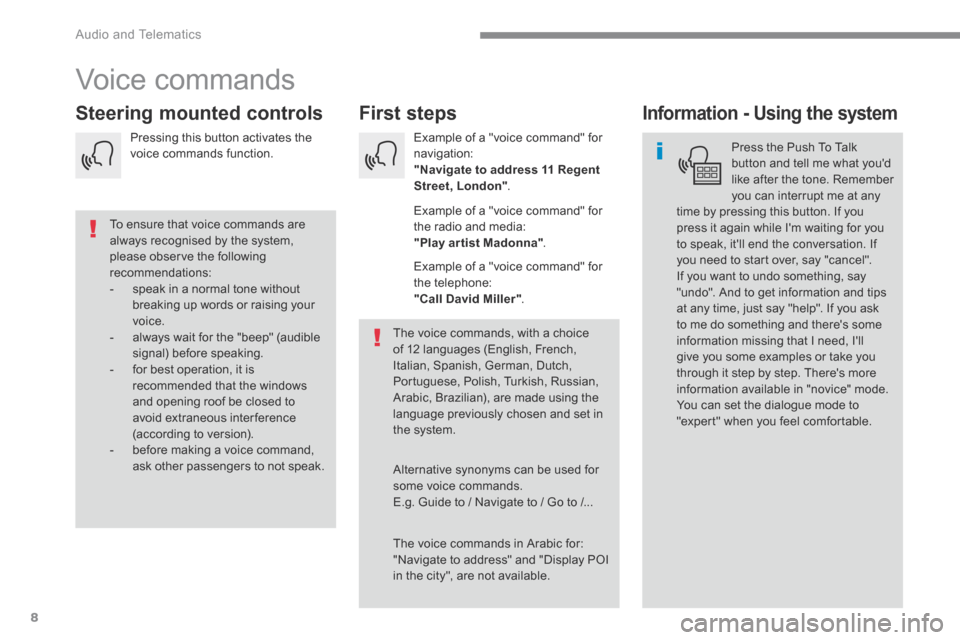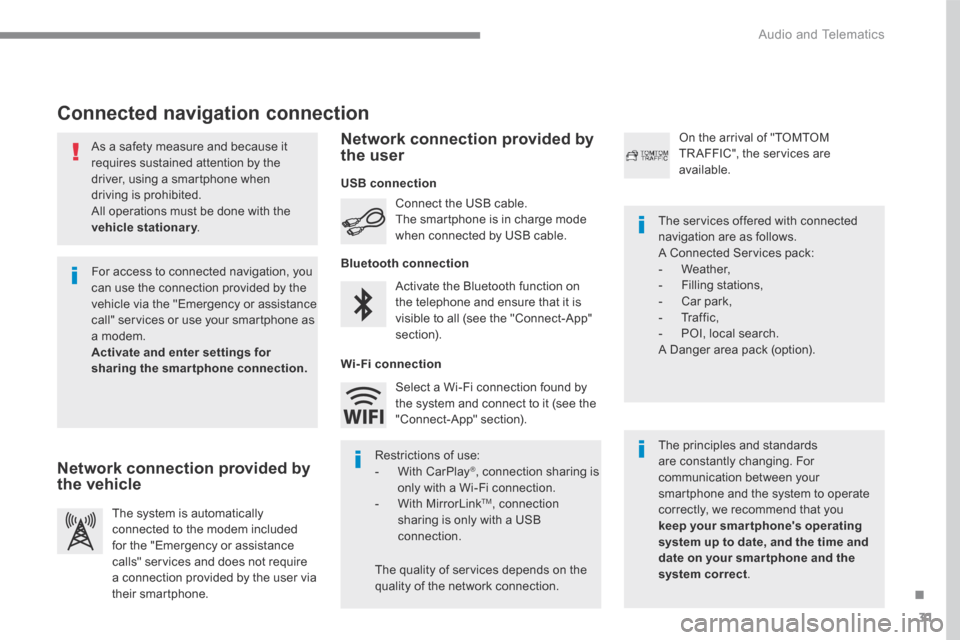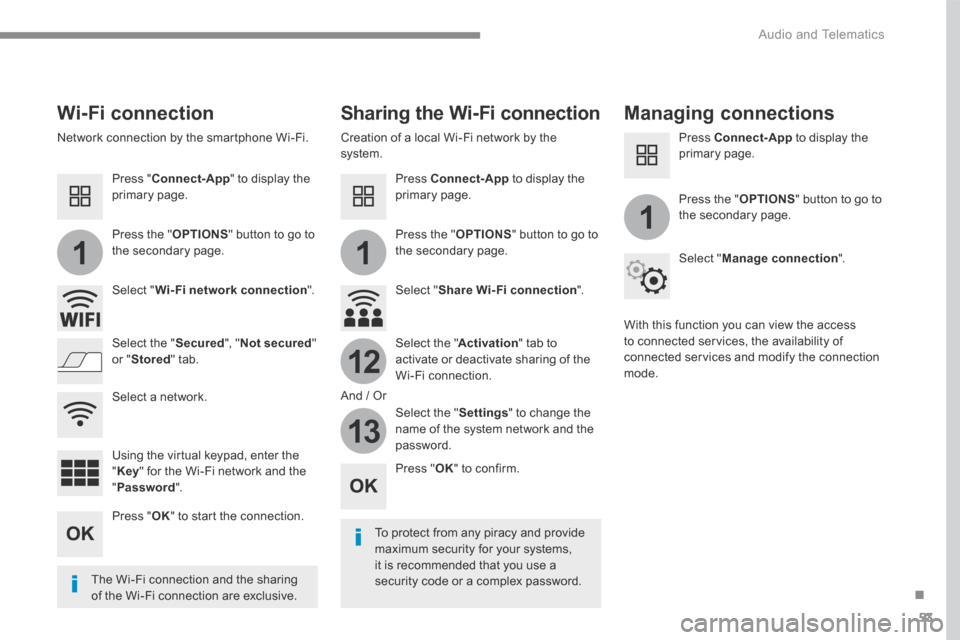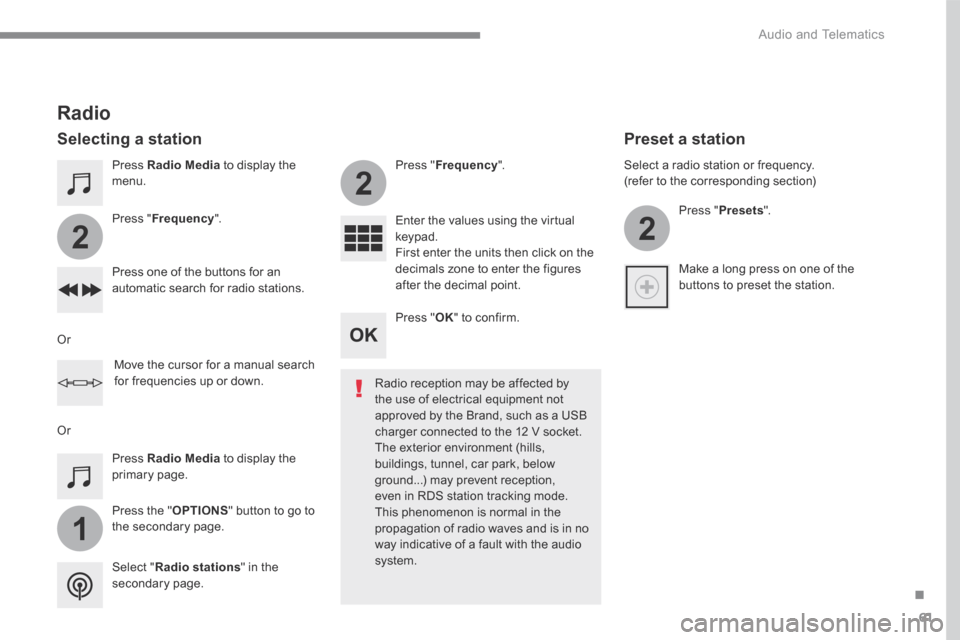2017 Citroen GRAND C4 PICASSO ECO mode
[x] Cancel search: ECO modePage 334 of 527

332
C4-Picasso-II_en_Chap09_caracteristiques-techniques_ed02-2016
Diesel weights and towed loads (in kg)
* The kerb weight is equal to the unladen weight + driver (75 kg).
* * T he weight of the braked trailer can be increased, within the GTW limit, if the GV W of the towing vehicle is reduced by an equal amount; warning,
towing using a lightly loaded towing vehicle may have an adverse effect on its road holding.
The GTW and towed load values indicated are valid up to a maximum altitude of 1 000 metres; the towed load mentioned must be reduced by 10 % for
each additional 1 000 metres of altitude.
When towing, the speed must never exceed 60 mph (100 km/h) (comply with the legislation in force in your country).
High ambient temperatures may result in a reduction in the per formance of the vehicle to protect the engine; if the ambient temperature is above 37 °C,
limit the towed load. Diesel engine
BlueHDi 115/120 S&SBlueHDi 135/150 S&S
Gearbox Manual (6-speed)EAT6 automatic
(6-speed) Manual (6-speed) EAT6 automatic
(6-speed)
Model code 3D... 3E... 3A... 3D... 3E... 3A... 3D... 3E... 3A... 3D... 3E... 3A...
BHZ - BHX...M/S - M/1S BHZ - BHX...
T/1S - T/2S AHX-AHR-AHV-
AHS...
M/S - M/1S AHX...
T/S - T/1S
Unladen weight 1 320 - 1 345 - 1347 1 320 - 1 357 - 1 359 1 415 - 1 428 - 1 430 1 435 - 1 474 - 1 476
Kerb weight* 1 395 - 1 420 - 1 422 1 395 - 1 432 - 1 434 1 490 - 1 503 - 1 505 1 510 - 1 549 - 1 551
Gross vehicle weight (GV W) 1 950 - 2 100 - 2 175 1 975 - 2 025 - 2 205 2 030 - 2 200 - 2 250 2 030 - 2 200 - 2 280
Gross train weight (MTR A)
on a 12% gradient 3 350 - 3 350 - 3 375 3 375 - 3 225 - 3 405 3 530 - 3 560 - 3 650 3 530 - 3 580 - 3 580
Braked trailer (within GTW limit)
on a 10% or 12% gradient 1 400 - 1 250 - 1 200 1 400 - 1 200 - 1 200 1 500 - 1 450 - 1 400 1 500 - 1 380 - 1 300
Braked trailer**
(with load transfer within the GTW limit) 1 600 - 1 550 - 1 500 1 600 - 1 500 - 1 500 1 700 - 1 750 - 1 700 1 700 - 1 680 - 1 600
Unbraked trailer 660 - 672 - 674 660 - 675 - 675 745 - 750 - 750 750
Recommended nose weight 70707070
Technical data
Page 338 of 527

336
C4-Picasso-II_en_Chap10_index-alpha_ed02-2016
Hands-free access ..........................................69
H ands-free tailgate ................................... 6 7, 69
Hazard warning lamps
......................... 2
30, 286
Hazard warning lamps, automatic operation
...............................
......................230
He
adlamp adjustment
................................... 2
20
Headlamps, automatic dipping
.....................2
17
Headlamps, automatic illumination
......21
2, 216
Headlamps, dipped beam
....... 2
4, 211, 304, 305
Headlamps, directional
........................ 2
22, 304
Headlamps, halogen
..................................... 3
04
Headlamps, main beam
... 2
4, 211, 304-306, 308
H
Date (setting) ............................... ....................52
Daytime running lamps ................ 2 19, 304, 308
Deactivating the passenger airbag
............... 2
42
Deadlocking
...............................
........ 54, 56, 58
Defrosting
...............................
.......................104
Defrosting, front
............................................ 10
4
Demisting
...............................
.......................104
Demisting, front
............................................. 10
4
Demisting, rear
......................................1
04, 208
Demisting, rear screen
.........................1
04, 208
Dimensions
..............................
.....................333
Dipstick
................
....................................42, 277
Direction indicators
........2
15, 220, 304, 307-311
Display screen, instrument panel
.................14
7
Doors
..............................................................
.62
Driver’s attention warning
.............................19
1
Driving economically ......................................... 9
Driving positions (storing)
...............................79
D
riving time warning
..................................... 19
0
Dynamic stability control (DSC)
..... 3
2, 233, 235
Eco-driving
...............................
........................ 9
Eco-driving (advice)
.......................................... 9
E
conomy mode
...............................
..............270
Electronic brake force distribution (EBFD)
...23
3
Emergency Braking Assistance (EBA)
.........23
3
Emergency call
............................................. 2
31
Emergency warning lamps
.................. 2
30, 286
Emissions control system, SCR
.....................37
E
nergy economy mode
.................................2
70
F
D
Fatigue detection ..................................19 0, 191
Filling the fuel tank ................................ 26
2-264
Filter, air
...............
......................................... 280
Filter, oil
......................................................... 28
0
Filter, particle
........................................2
79, 280
Filter, passenger compartment
..................... 28
0
Fitting a wheel
...............................
................300
Fitting roof bars
............................................. 2
72
Fittings, boot
................................................. 11
9
Fittings, interior
..................................... 10
7, 108
Fittings, rear
...............................
...................113
Flap, fuel filler
...............................
.........262, 263
Flashing indicators
................................2
15, 220
Floor, concertina
............................................. 89
F
oglamps
..............................
........................304
Foglamps, front
............. 2
13, 221, 304, 307, 312
Foglamps, rear
.............................. 2
13, 308, 310
Folding the rear seats
.................. 8
4, 86, 88, 89
Fuel ............................................................9, 264
Fuel consumption
........................................ 9
, 51
Fuel tank........................................................ 263
Fusebox, dashboard
..................................... 3
13
Fusebox, engine compartment
..................... 3
13
E
Engine compartment ............................ 275, 276
Engine, Diesel ........ 2 5, 264, 276, 324, 329, 330
Engine, petrol
............................... 2
64, 275, 325
Engines
..............................
.......... 325, 329, 330
Environment
...............................
.................9, 59
ESC/ASR
...............................
........................233Fuses ................
.............................................
313
Gauge, fuel.................................................... 262
Gearbox, automatic
.......... 9
, 142, 148, 281, 318
Gearbox, manual
...................... 9
, 141, 148, 281
Gear efficiency indicator
...............................14
7
Gear lever
..............................
........................... 9
Gear lever, manual gearbox
.........................1
41
Glove box
..............................................10
7, 108
G
Alphabetical index
Page 354 of 527

1
.
Audio and Telematics
CITROËN Connect Nav
GPS satellite navigation - Applications - Multimedia audio - Bluetooth ® GPS satellite navigation - Applications - Multimedia audio - Bluetooth ® GPS satellite navigation - Applications - Multimedia audio - Bluetooth telephone ® telephone ®
Contents First steps 2
Steering mounted controls 5
Menus 6
Voice commands 8
Navigation 14
Connected navigation 30
Applications 40
Radio Media 54
Telephone 66
Settings 78
Frequently asked questions 88
The system is protected in such a way that it will only operate in your vehicle. Displaying of the Energy Economy Mode message signals that a change to standby is imminent.
The different functions and settings described vary according to the version and configuration of your vehicle.
The link below gives access to OSS (Open Source Software) codes for the system. http://www.psa-peugeot-citroen.com/oss
As a safety measure and because it requires sustained attention by the driver, the pairing of a Bluetooth mobile telephone with the Bluetooth hands-free system of your audio system must be done with the vehicle stationaryand the ignition on.
Page 361 of 527

8
Audio and Telematics
Voice commands
First steps Steering mounted controls Information - Using the system
Press the Push To Talk button and tell me what you'd like after the tone. Remember you can interrupt me at any time by pressing this button. If you
press it again while I'm waiting for you to speak, it'll end the conversation. If you need to start over, say "cancel". If you want to undo something, say "undo". And to get information and tips at any time, just say "help". If you ask to me do something and there's some information missing that I need, I'll give you some examples or take you through it step by step. There's more information available in "novice" mode. You can set the dialogue mode to "expert" when you feel comfortable.
To ensure that voice commands are always recognised by the system, please observe the following recommendations: - speak in a normal tone without breaking up words or raising your voice. - always wait for the "beep" (audible signal) before speaking. - for best operation, it is recommended that the windows and opening roof be closed to avoid extraneous interference (according to version). - before making a voice command, ask other passengers to not speak.
The voice commands, with a choice of 12 languages (English, French, Italian, Spanish, German, Dutch, Portuguese, Polish, Turkish, Russian, Arabic, Brazilian), are made using the language previously chosen and set in the system.
The voice commands in Arabic for: "Navigate to address" and "Display POI in the city", are not available.
Alternative synonyms can be used for some voice commands. E.g. Guide to / Navigate to / Go to /...
Example of a "voice command" for navigation: "Navigate to address 11 Regent Street, London" .
Example of a "voice command" for the radio and media: "Play ar tist Madonna" .
Example of a "voice command" for the telephone: "Call David Miller" .
Pressing this button activates the voice commands function.
Page 384 of 527

31
.
Audio and Telematics
As a safety measure and because it requires sustained attention by the driver, using a smartphone when driving is prohibited. All operations must be done with the
vehicle stationary . vehicle stationary . vehicle stationary
Connected navigation connection
The principles and standards are constantly changing. For communication between your smartphone and the system to operate correctly, we recommend that you keep your smar tphone's operating system up to date, and the time and date on your smar tphone and the system correct.
The services offered with connected navigation are as follows. A Connected Services pack: - Weather, - Filling stations, - Car park, - Traffic, - POI, local search. A Danger area pack (option).
Activate the Bluetooth function on the telephone and ensure that it is visible to all (see the "Connect-App" section).
Connect the USB cable. The smartphone is in charge mode when connected by USB cable.
The system is automatically connected to the modem included for the "Emergency or assistance calls" services and does not require a connection provided by the user via
their smartphone.
On the arrival of "TOMTOM TR AFFIC", the services are available.
For access to connected navigation, you can use the connection provided by the vehicle via the "Emergency or assistance call" services or use your smartphone as a modem. Activate and enter settings for sharing the smartphone connection.
Restrictions of use: - With CarPlay ® , connection sharing is only with a Wi-Fi connection. - W i t h M i r r o r L i n k TM , connection sharing is only with a USB connection.
The quality of services depends on the quality of the network connection.
Select a Wi-Fi connection found by the system and connect to it (see the "Connect-App" section).
USB connection
Network connection provided by the vehicle
Network connection provided by the user
Bluetooth connection
Wi-Fi connection
Page 396 of 527

43
.
2
Audio and Telematics
As a safety measure and because it requires the sustained attention of the driver, using a smartphone when driving is prohibited. Operation must be with the vehicle stationary . stationary . stationary
The synchronisation of a smartphone allows applications on a smartphone that are adapted to the CarPlay ® technology ® technology ®
to be displayed in the vehicle's screen, having first activated the CarPlay ® function in the smartphone. As the principles and standards are constantly changing, it is recommended that you keep your smar tphone's operating system updated . For the list of eligible smartphones, go to the Brand's internet website in your c o unt r y.
Connect a USB cable. The smartphone charges when connected by a USB cable.
Connect a USB cable. The smartphone charges when connecte d by a USB cable.
Press " Telephone " to display the CarPlay ® inter face. ® inter face. ®
Press " CarPlay " to display the CarPlay ® inter face ® inter face ®
On connecting the USB cable, the CarPlay ® function deactivates the ® function deactivates the ®
system's Bluetooth ® mode. ® mode. ®
In the system, press " Applications " to display the primary page.
Or
Press " Connectivity " to go to the CarPlay ® function. ® function. ®
Page 406 of 527

53
.
11
1
12
13
Audio and Telematics
Wi-Fi connection Sharing the Wi-Fi connection Managing connections
To protect from any piracy and provide maximum security for your systems, it is recommended that you use a security code or a complex password. The Wi-Fi connection and the sharing
of the Wi-Fi connection are exclusive.
Press " OK " to confirm.
Press " OK " to start the connection.
Press " Connect-App " to display the primary page.
Network connection by the smartphone Wi-Fi. Creation of a local Wi-Fi network by the system.
Press Connect-App to display the primary page.
Press Connect-App to display the primary page.
Press the " OPTIONS " button to go to the secondary page. Press the " OPTIONS " button to go to the secondary page.
Press the " OPTIONS " button to go to the secondary page.
Select " Wi-Fi network connection ". Select " Share Wi-Fi connection ".
Select " Manage connection ".
And / Or
Select the " Secured ", " Not secured " or " Stored " tab. Select the " Activation " tab to activate or deactivate sharing of the Wi-Fi connection.
Select the " Settings " to change the name of the system network and the password.
With this function you can view the access to connected services, the availability of connected services and modify the connection mode.
Using the virtual keypad, enter the " Key " for the Wi-Fi network and the " Password ".
Select a network.
Page 414 of 527

61
.
1
2
2
2
Audio and Telematics
Press Radio Media to display the menu.
Press the " OPTIONS " button to go to the secondary page.
Press " Frequency ".
Press " Frequency ".
Enter the values using the virtual keypad. First enter the units then click on the decimals zone to enter the figures after the decimal point. Press one of the buttons for an automatic search for radio stations.
Press Radio Media to display the primary page.
Radio
Selecting a station
Radio reception may be affected by the use of electrical equipment not approved by the Brand, such as a USB
charger connected to the 12 V socket. The exterior environment (hills, buildings, tunnel, car park, below ground...) may prevent reception, even in RDS station tracking mode. This phenomenon is normal in the propagation of radio waves and is in no way indicative of a fault with the audio system. Select " Radio stations " in the secondary page.
Or
Or
Move the cursor for a manual search for frequencies up or down.
Select a radio station or frequency. (refer to the corresponding section)
Press " Presets ".
Make a long press on one of the buttons to preset the station.
Preset a station
Press " OK " to confirm.